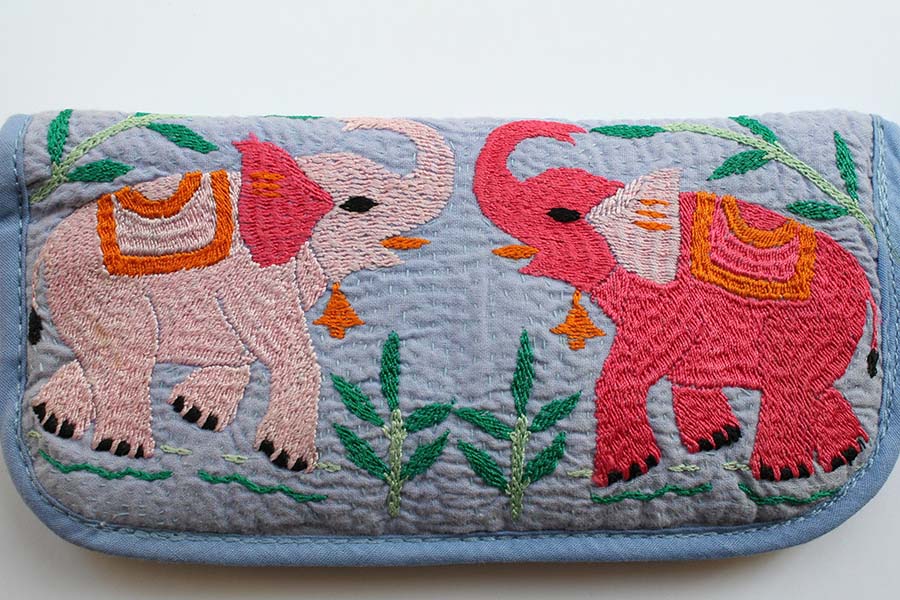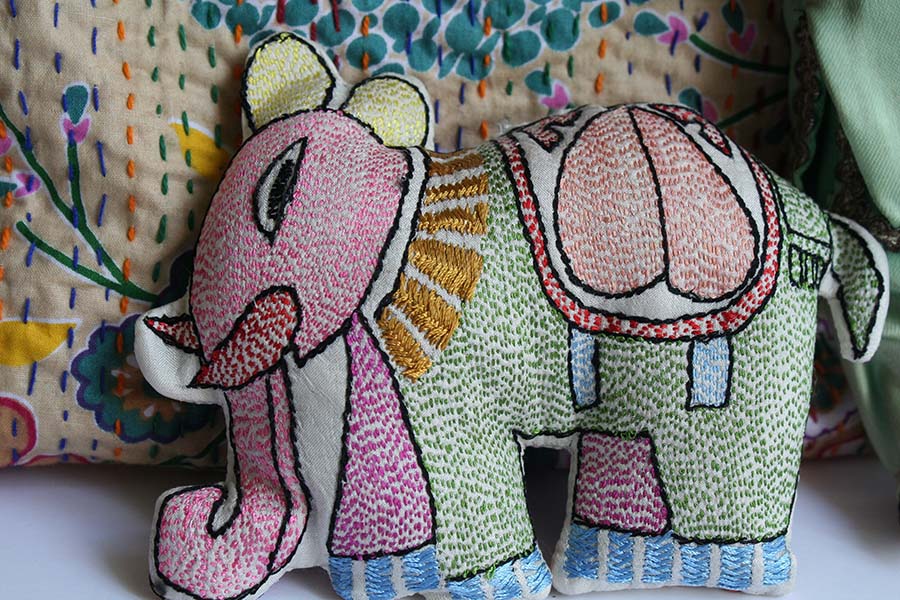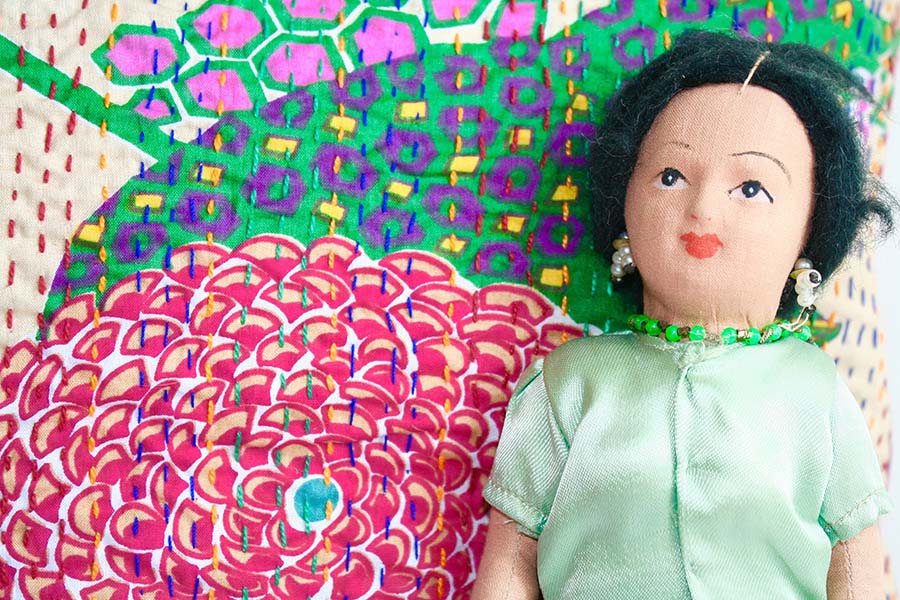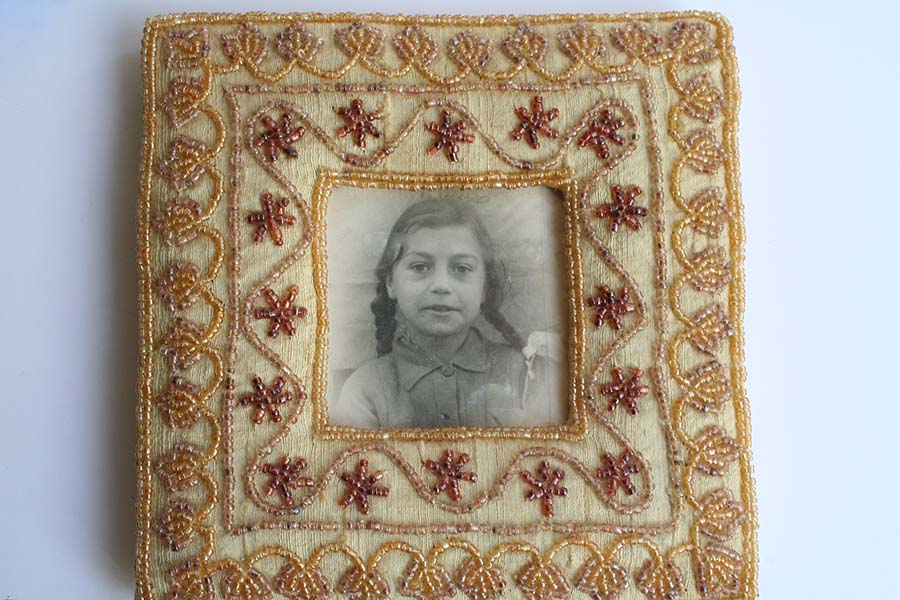India’s rich textile history informs a new wave of designers, Susie Lau meets the colourful designer Manish Arora and the Duchess of Cambridge stands out in a crowd.
What do Style Bubble blogger Susie Lau and Indian Prime Minister Narendra Modi have in common? They’ve both made three-day flying visits to each other’s countries recently. Modi met up with UK PM David Cameron to shake hands on a ‘Team London, Team UK … winning combination!’ business alliance with India, one of the world’s fastest growing major economies. And Susie Bubble was delighted to tick off one of her Bucket List items, her first visit to India. Presenting her with the plane tickets and curated itinerary was the V & A museum, keen to involve one of the most influential figures in the fashion business in its current Fabric of India exhibition. The exhibition, which looks at the history of Indian textiles and fashion right up to the present day is a must-see if you’re working with or interested in textiles, beading, embroidery, fabric dying, weaving, embellishing, quilting, design….
The importance of India in the history of the world’s textile trade and skills cannot be underestimated and this exhibition, bringing together hundreds of handmade textiles going back at least 6000 years – yes, you need to think about that number – contains some of the finest textiles ever made. It was haute couture taken to its limits, where the extreme wealth of the Indian rulers combined with the phenomenal skills of the best craftsmen, using the finest materials. So we see the best silks, finest muslins, softest goat-hair pashmina, silver and gold threads, astonishing weaving methods, to unrivalled weaving, embroidery and beading techniques.
And that astonishing attention to detail is present today. One of the highlights of the exhibition is a brightly multi-coloured figure-hugging floor-length gown in yellows, pinks, blues and purples, featuring 1,500 individual handmade butterflies, hand-embroidered and hand-sewn onto the dress. Its creator, the business student turned fashion designer Manish Arora, is regarded as India’s formost fashion designer, and undoubtedly the most successful in international terms.
Arora, who is Paris-based, will create his 17th show there next season. He has a flagship store in the smart 1ier arrondissement and a factory in Delhi’s garment district, where he showed Susie Lau around. They met again when she was invited to interview him as part of The Fabric of India exhibition in front of a large audience, behind them a giant slideshow of glorious costumes (the best word) from his collections. His work embodies colour, complex craftsmanship and embellishment, and a certain quirkiness – his two-season stint as artistic director at Paco Rabanne saw Lady Gaga and J-Lo dressed by him, and collections have been inspired by Game of Thrones, Disney, the space age, fantasy, Bollywood, Indian Pop Culture. ‘Basic ideas’, says Arora. He has a fondness for topping off his looks with baseball caps…! His S/S 2016 collection he calls ‘Disco gypsyland’ and told his V & A audience it was all about ‘Jerry Hall, Bianca Jagger, Studio 54, mixed with my Indianness!’ Other high-profile wearers have included Katy Perry, Nicki Minaj and Beth Ditto – for the girl who likes to stand out, you might say.
After he launched in 2000, he was soon talent-spotted by the British Fashion Council and has shown in London four times now. But Paris, the European heart of excellence in couture, soon came calling, and the city has embraced him. He is the first and only Indian designer to have shown there. Varied big-business collaborations have involved Swarovski and MAC, among others. MAC launched the colour ‘Pink Manish’, at his request. ‘Pink is my religion!’
Susie Lau is known for her trademark bold colours and patterns, but has also said she’s a fan of ‘slow fashion’. On her trip to India she was fascinated by the traditional techniques and embroidery and the fact that the motifs ‘were anything but!’ This, she said, is the reason Arora’s work ‘has managed to resonate on a wider scale’.
He and Lau talked about marrying modern fashion and design ideas, materials and techniques with traditional skills in a traditional environment, where the artisans are almost always male, living away from their families for months at a time. Lau asked him if there were challenges getting his company’s artisans to work with motifs unfamiliar to them. ‘Sometimes it’s difficult to explain to them that the embroidery is different, that we can go beyond a traditional flower and yes, times have changed.’ Now though, he says, every six months [when they start to look at the new collection] ‘my workers are very excited to see what is next!’
Royal blue in demand
Another Indian-born designer, Saloni Lodha, who kick-started her business with a short course at St Martin’s, saw demand for one of her day dresses spike and then sell out instantly when it was worn by the Duchess of Cambridge for an awards presentation in London recently. The label, Saloni, was already hanging in the wardrobes of PM’s wife Samantha Cameron and high-profile actresses and models (Emma Watson, Rosie H-W). Screen star Carey Mulligan already had the exact same dress, a demure Sixties-influenced, box-pleated V-backed number with a nipped-in waist in a vibrant ultramarine blue. The polyester/polyamide fabric was cut from matelassé (pronounced mat-lah-say), a thicker woven fabric where the pattern appears quilted or padded but isn’t. The £555 Martine midi-dress, which had been available at several UK outlets including Matches, is slightly unusual for the designer, who usually parlays her ideas into interesting prints. Black and white polka dots are a strong trend for her currently, and there are demure, feminine, chiffony arms and full-length ‘cute/prim’ Seventies stories going on too. Buckingham Palace has just announced that the Duke and Duchess of Cambridge will be undertaking a royal tour of india in the spring: Catherine Middleton is bound to be flying the flag for fashion, both indian and British.
Check out salonilondon.com not least for the sparkling Ellen Von Unwerth video Jodphur Jackie, to the catchy ‘Ina Meena Dika’ song by Kishore Kumar from the 1994 Bollywood film. (It would have been lovely to have had this lively backdrop to the stunning but rather staid ‘modern’ section of the Fabric of India exhibition.)
Abandoned in New York: a jewel in the show

There are many highlights in the Fabric of India exhibition, which merits more than one visit. One of the most striking, not to say largest at 17 metres in length, is a room-sized wall decoration with three window holes – think of the interior of a fabric marquee – handmade and appliqued with large blue elephants, human figures and Hindu gods, in bold, bright colours of red, yellow, blue and white. Since identified by V & A experts as a fine example of Indian folk art, it is thought to be a Saurashtran ceremonial wall hanging, traditionally been used to decorate an interior for an Indian wedding or other celebration. It was probably made in Gujarat in around the 1920s. It’s hard to be exact because it was found in the early 1990s dumped unceremoniously among the beer crates outside a warehouse on a New York pavement. The bittersweet tale has a happy ending: a US ‘art appraiser’, a Mr Jerome Burns, spotted the abandoned bundle while passing by in Brooklyn, arranged a van and some friends and rescued it. Some years later he offered it to the V & A as a gift, but sadly didn’t live to see his find enjoying one of its finest moments and being seen by the public for the first time (too big for the V & A to display previously).
The Fabric of India exhibition forms part of the V & A India Festival and runs until 10 January 2016. You can see a video of the wall hanging in situ and get the full story on the V & A blog (A Room With A View, from May 14 2015). There’s a gorgeous book to accompany the exhibition, some really well thought out merchandise in the shop – gorgeous throws, funky budget earrings as well as some more serious jewellery – and admission is £14, free for members, open daily. More information from vam.ac.uk or by phoning 0207 942 2000.
Export Skills

Some of the most covetable items in my own mini ‘Indian collection’, such as this colourful elephant lavender ‘bag’ embroidered exquisitely on both sides, have come from Bangladesh, created by women who until very recently had never held a needle. Textile graduate Sophie Pattinson had enjoyed a very successful career making large-scale works for public and corporate clients but now runs a Fair Trade company to generate income for the women via their own hand embroidery. She provides the designs and the high quality materials, often donated, and teaches the women embroidery. Designs including animals, birds, turbans and kantha are beautifully embroidered onto silk and cotton bed linen, cushions, kimonos and other items. Not only do the women earn money to enable their children to be educated, says Sophie from her Hampshire studio, it also raises their status in the community. You can see and buy some of their work here.
DIY Embroidery








 We’re thrilled to announce that we’ve partnered with Tree Nation, the platform to reforest the world & fight climate change! Home to over 90 planting projects in 33 countries, Tree Nation is a non-profit organisation that helps people & companies offset their CO2 emissions.
We’re thrilled to announce that we’ve partnered with Tree Nation, the platform to reforest the world & fight climate change! Home to over 90 planting projects in 33 countries, Tree Nation is a non-profit organisation that helps people & companies offset their CO2 emissions.